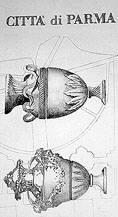 |
 |
The Basics:
Parma is a city of 200,000 people, rich with culture, art, tradition and history. Its Cathedral, built in the 13th century on the ruins of an earlier structure, is a renowned example of the romanesque style in the Po valley, with a cupola painted by the artist Correggio in the sixteenth century; also located in the Piazza Duomo is the ancient Baptistery, an octagonal structure made of pink marble, an expression of the transition into Gothic styles.
Other important parts of Parma include the Old San Giovanni Pharmacy, Steccata's Church, the Camera di San Paolo, the Duke's Palace & Park, the Regio Theater, the Pilotta (explained below) and many other sites. Parma is also home to a university that was began in the ninth century, now with about 20,000 students.
While it is an urban center, Parma is also surrounded by beautiful nature, with nearby green hills, fertile countryside, seasonal flowers and plentiful vineyards, as well as the Po River that divides the city in half.
Location:
Parma is situated in Emilia-Romagna, a region of northern Italy. It is in a central geographical position, on the west-east axis of the via Aemilia, as well as the north-south route from the Po River valley to Liguria and Tuscany. The city is easily-accessible, located halfway between Milan and Florence, both about two hours away by train or car.

History:
Parma was founded in 183 B.C. by 2000 Roman citizens as part of a colonization project in which the nearby towns of Piacenza, Modena and Bologna were also established. The city's main development spans from the Middle Ages through the eighteenth century, as it became involved with every major artistic period and cultural institution.
In the Byzantine period, Parma became known as Chrysopolis -- "golden city" -- due either to the richness of its soil or its administrative seat of the Treasury. During the Imperial Age, Parma had a forum (in today's Piazza Garibaldi), a theater, an ampitheater, public baths and a basilica. The flourishing town saw the rule of the Visconti, the Sforza, the French and the Papacy from the 14th to 16th Centuries, and in 1545 Pope Paul III established a Duchy with his son Pier Luigi Farnese as its ruler (a dynasty that lasted almost 200 years).
The years between 1802 and 1814 were a time of Napoleonic rule, following with the important period when the city's administration was passed to Bonaparte's second wife, Maria Luigia of Austria, whose influencial power lasted until her death in 1847. After the Bourbons regained control for a short period, Parma was joined in the Kingdom of Italy with a plebiscite on March 18, 1860.
Sources of Fame & Pride:
Quite famous for its fine cuisine (and known to some as "Food Valley," Parma specializes in two foods: Parmigianno-Reggiano formaggio (cheese), and prosciutto (ham). Both delicacies are revered and consumed on a national level, as well as the Parmalat and Barilla food products, founded in Parma.
In addition to these edibles, Parma takes great pride in its people. Throughout history, many notables have had their roots and work in this city: artists Correggio, Parmigianino and Paolo Toschi, film director Bernardo Bertolucci, and Giuseppe Verdi and Arturo Toscanini in music.
The Pilotta:
Home to the Toschi Institute of Art, this colossal structure is located between the Parma's Po River and Via Garibaldi. It was built between 1580 and 1620 as a Court Palace during the rule of the Farnese family, designed by the architect Giovanni Boscoli de Montepulciano. The name of the construction derives from the game of "pelota," which was played in one of the three courtyards (Guazzatoio, S.Pietro Martire and Rocchetta). Largely destroyed by an apocalyptic air raid in 1944, the south and west wings of the Pilotta were later rebuilt in the early post-war years.
Today it is one of the most important cultural centers of Parma, holding a number of prominant establishments: the Palatina Library, the National Archeological Museum, the Farnese theater, the Bodoni Museum and the National Gallery.
Links to Other Parma Sites:

a student's artwork
[ return to MAIN PAGE ]
[ letter home #1 |
story #3 |
brainflow I |
brainflow II |
writings |
dreams ]